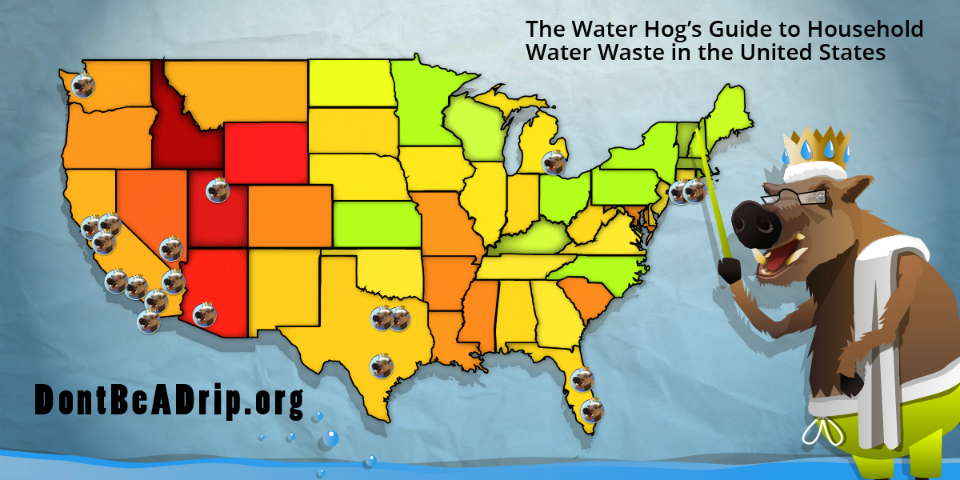Americans use more water per person than anyone else in the world. To the tune of 27 billion gallons of water dripping through U.S. households every single day via our washing machines, showers, faucets, toilets, and sprinklers. In many areas, fresh water may be drawn from rivers, lakes and streams. When people waste this water, it can alter ecosystems and dry out the habitats of the country’s wildlife species, many of which have become threatened or endangered as a result.
It’s time for us to stop hogging all the water and start saving some for wildlife.
As part of LS&Co.’s ongoing commitment to water stewardship, we’ve partnered with the Center for Biological Diversity on the “Don’t Be A Drip” campaign, which aims to demonstrate the impact of household water consumption on wildlife species.
On the campaign website, consumers can learn more about household water consumption across the United States, including the areas with the highest daily per capita household water consumption, as measured by the U.S. Geological Survey. Coined “water hogs,” top offenders include Maricopa County (Arizona), Riverside County (California), Salt Lake County (Utah), Sacramento County (California), and Palm Beach County (Florida). The campaign empowers individuals to change their habits in order to protect wildlife. For example, pledging to wash their jeans less to save water. Consumers are encouraged to do their part to help raise awareness by sharing the campaign with their social networks.
“It’s easy to forget that every time you turn on the tap, that water is coming from rivers, lakes and streams that wildlife depend on,” said Stephanie Feldstein, population and sustainability director at the Center for Biological Diversity who helped create the campaign. “The reality is that water is a finite resource, and careless human water consumption is altering our ecosystems, destroying natural habitats and sapping water sources for birds, fish, mammals and other wildlife.”
Key findings highlighted in the campaign include:
- Six out of the top 10 “water hog” states pull from the Colorado River, where water levels have dipped to record lows due to the historic drought, population growth and outdated water rights, raising alarm among water managers and conservationists. Residents in these states use an average of 139 gallons of water per person, per day, compared to the national daily per capita average of 80 to 100 gallons of household water use.
- In Nevada, where high water usage is depleting groundwater resources, the Salt Creek tiger beetle now faces extinction, having lost valuable saline mudflats and wetlands. Scientists use the tiger beetle’s presence as an indicator of the overall ecosystem health; its disappearance indicates broader environmental damage impacting many other species.
- Despite its historic drought, California has more top water-consuming counties – counties with the highest daily per capita water use – than any other state. This water, critical to supporting species like the San Joaquin kit fox, is too often wasted for landscaping. The kit fox is considered an umbrella species, meaning efforts to save the kit fox’s habitat will benefit other native plants and animals, helping the entire ecosystem. By xeriscaping — landscaping with native, water-saving plants — every California home could save 18,000 gallons of water a year.
“For many of us, running the shower or leaving the water on when washing the dishes has become an unconscious habit,” said Michael Kobori, LS&Co.’s vice president of sustainability. “We want consumers to realize that every wasted drop of water down the drain negatively impacts countless ecosystems. This campaign aims to remind consumers to wake up and turn off their autopilot behaviors.”
LS&Co. has taken great efforts to understand the environmental impact of our products through two lifecycle assessments. As a result of these findings, LS&Co. has made strides in reducing its water usage, saving more than 1 billion liters of water through its Water<Less™ finishing process, while also educating consumers about reducing water and energy consumption through the introduction of the Care Tag for Our Planet in 2009, the Field of Jeans initiative, the “Are You Ready to Come Clean” quiz, and most recently, a look at how much time, energy and money could have been saved if Levi’s®-wearing Californians followed the company’s consumer care recommendations over the past four years.
Learn more by visiting www.DontBeADrip.org.
Like this story?
Sign up for the Unzipped newsletter to get the best of the Unzipped blog — company news and views, employee profiles, innovation and sustainability stories, behind-the-scenes and Archives highlights — sent straight to your inbox weekly.







